|
Every child in Germany or Denmark grows up with the unexpurgated fairy tales of Hans Christian Andersen. Bloody tales in which Cinderella's stepsisters cut off their toes and heels to fit into the dainty slipper; where a horse speaks while its head is nailed to a gate; and where a little mermaid gets her tongue cut off in exchange for human legs, so she can perhaps be loved by a Prince. In Andersen's very lyrical story it's heartbreaking that the little Mermaid can't speak to tell the Prince about herself or her sacrifice, or about having saved him from drowning. What makes the story so compelling that even Walt Disney had to retell it in a cleaned-up, sugar-coated version, is this old-world archetype of a young woman in love. The child-woman who has no voice, just innocence, beauty, grace, and an inexhaustible capacity to suffer for love… in silence. Andersen draws no curtain over her masochism: every graceful step cuts through her like a knife, the author reminds us at every turn. Once she fails to win the Prince's love, she has to kill him if she wants to save her own life. If she wants to regain her fishtail, she has to let his blood run over her pretty legs… We all know how such a story is going to end.
What we don't know is how a mute art like ballet can render this drama of muted love. Hamburg Ballet's long-time director and choreographer John Neumeier has produced an answer in a big blockbuster production of a ballet, created in 2005 for the Royal Danish Ballet as an homage to Hans Christian Andersen. Celebrating the writer's bicentenary, the music for the ballet was commissioned from modern composer Lera Auerbach. It was announced as a "Little Mermaid for adults," a quite unnecessary warning if you read the original tale. All of Andersen's fairy tales were consciously written for both children and adults. But there is a difference in reading a cruel story in a poetic language that veils and uses inference, and being shown the cruelty in merciless detail and with even more brutality than the story already holds.
In Andersen's fairy tale, the mermaid still retains her magical beauty and gracefulness, out-dancing every human woman. Neumeier, however, leaves her with nothing. Her human legs don't work for her; she is a klutz, a crippled waif who sits in a wheelchair on deck of the ocean cruiser where her rival cavorts with the Prince and his merry entourage. The sailors stick her into a sailor-boy's outfit and make fun of her clumsy attempts to join in, but this is only the beginning of her humiliation. It continues at the court and during the Prince's wedding festivities. For the Prince, she is only a child-toy, an oddity like some sort of dwarf or court jester whom he loves to tease and then ignore.
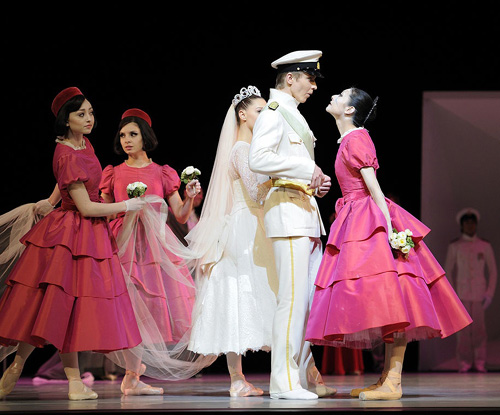 |
In the course of her calvary à la Neumeier, this Little Mermaid learns nothing. She never manages to walk and dance, she never becomes a possible love interest, and she continues to the end to be an abject beggar for even a glimpse from the callous Prince for whom she has her deadly obsession. "I don't know of another story in literature," Neumeier is quoted as saying, "with such a vision of love." This relentless pleading and clawing is supposed to be love? Why on earth would the Prince choose her, a grotesque, sad, broken puppet?
And why on earth did John Neumeier choose to tell this brutal tale in a ballet that robs its heroine of dance and grace and beauty?
It turns out that Hans Christian Andersen had similar experiences of unrequited love; that he was devastated by the marriage of a man he adored, whereupon he wrote this devastating tale, his perhaps most autobiographical work. Neumeier uses the author, here called The Poet, to tell two stories at the same time: the rejection by society of a poet with homoerotic leanings who invents a female character and sends her through the turmoil he himself experienced. This could be an interesting proposition, and for a few moments, at the beginning, I believed Neumeier was onto something.
The story opens with a blue neon tube curving across the entire black stage. A window opens in the space right above. We are looking at a brightly lit deck of an ocean liner where a man reads a book. On the white sky behind him, the beginning lines of the fairy tale are written. The blue neon tube sways up and down below the window: the surface of the sea. A brief, glittering wedding scene onboard leaves the Poet out; he cries a tear, the tear falls into the sea and he lets his body glide after it into the black space as the neon-blue water line rises above the man and closes the window.
The simplicity of this stark scene of depression and foreboding death could have set the stage for the entire fairy tale. Unfortunately, Neumeier gets busy instead. He does not seem to realize his own potential for poetic economy. There are many other spectacular scenic ideas and images, all created and designed by Neumeier himself (showing him in the hub of European theater inspiration). Beautiful ocean liners glide atop the sea space, every one lit up and festive like a mythic Titanic. Neumeier's father apparently was a sea captain, and the most evocative sets are all linked to the sea and its ships. During the storm, these majestic ocean liners are seen slowly descending, upside down, like toys through the blue space that is now crossed by the undulating wave-lines of several white neon tubes.
What does the choreographer do with these stunning sets and images? He busily fills them with …fillers. Groups of boring mermaids and mermen, sailors, stewards, stereotypical wedding guests and banal princely entourages etc. get a lot of stage time and nothing of any interest to dance. (Where is Matthew Bourne when he is needed?) They are neither characters nor caricatures. The same holds true, alas, of most of the protagonists, especially the Poet (blandly acted and danced by Damian Smith).
Oddly, the Poet who sets the tale into motion on the dreamy bottom of the sea doesn't appear as a romantic, spurned lover but as a clumsy, klutzy, Chaplinesque puppet-master and puppet of his own story. Neumeier won't allow him his love story with the Prince, nor does he become a true soul brother to his fairy tale creation (Andersen confessed to feeling "like a woman" when he was in love). The Poet remains an unengaging abstraction — a "Creator" who pushes the innocent mermaid at the Prince.
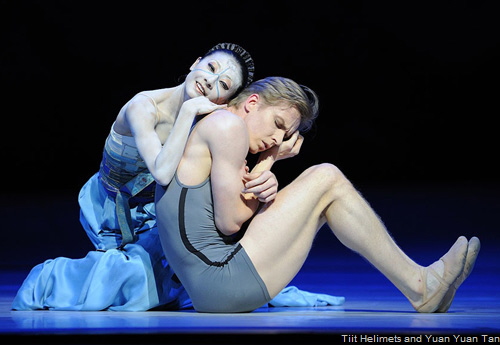 |
The Prince, danced by Estonian Tiit Helimets, has enough personality and lovely, light-hearted dances with ladies and golf clubs to carry the day as a self-loving charmer without depth. His Princess, Sarah van Patten (recently seen here as the Swan Queen, cold as a fish) employs her charm, too, but doesn't have either the choreography nor the personality to create more than a stereotype. This is disturbing as she gets to dance a lot without creating interest or feeling, while the main character, i.e. the Mermaid, can't dance but has to carry the whole burden of the emotional drama.
The Mermaid's role is a tour de force in every way. At first the dancer, Yuan Yuan Tan, has to negotiate silk pants that are a whole yard too long so as to be stretched out as her fishtail while she is carried around by three Noh-style figures. At moments the effect of a floating fish-creature works its magic, but the manipulations are also laborious and the beauty of floating is marred by the all-too busy nonstop gesticulations of the dancer's arms as if she had to signal every second, look, look, I am a fish, I have fins, I am waving, how exciting!
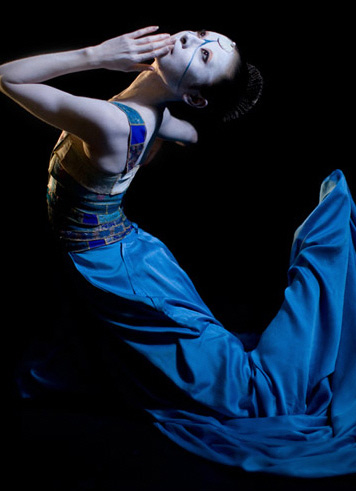 |
This goes on way too long (every scene, in fact, goes on way too long) until finally the brutal, rape-like cutting of her tail gives her those coveted human legs (Armenian principal Davit Karapetian is a dynamo as the Sea Witch). For the next hour the Mermaid has to hobble on those legs that won't hold her up. Yuan Yuan Tan does it to perfection, sometimes stiff like a Coppelia-like puppet or flailing like a clumsy Petrushka, sometimes like a toddler learning to walk, most often like a cripple desperate to control what she can't. It's painfully grotesque and grossly painful to watch because there is no redemption and no progress. Apart from a few attempted dance steps here and there she is stuck in her creepy state. She even begins to look creepy in her pale Mermaid-painted face sticking out of a bridesmaid dress in loud pink.
There are only a few moments when this story is touching. One of them is the opening of Act II, when a small white box is lit up at the front of the huge black stage. In it, there is room for only a chair. Huddled in the corner is the Mermaid in a drab school girl's dress. She can't move. After the vast freedom of the ocean, here is another brilliant metaphor for her state of self-sacrifice, the cell, the cage, the insane asylum of her soul. Neumeier gives her interesting knotted ways of trying out her legs, and in the end she uses those tight walls of the cell to do some desperate ballet steps as if she were holding onto a bar, before she manages to slip out.
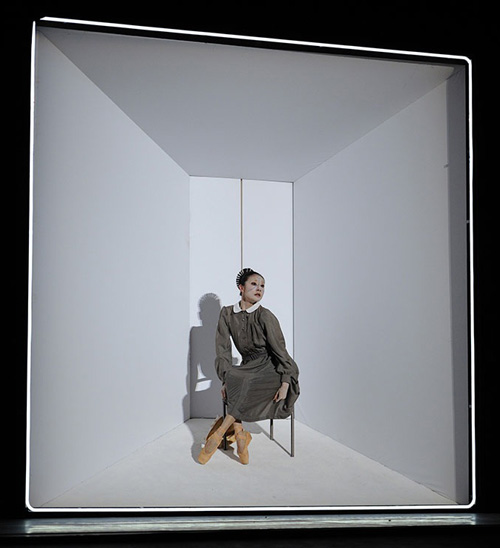 |
At this point, one still hopes that the choreographer would let her finally gain control and grow into the dreamlike dancer she is in the fairy tale, so that one's hopes for her and the drama of her possible success would rise and peak. How could Neumeier not be tempted by the obvious thrill of dance? There's a whole tradition of otherworldly, in-between creatures in ballet, from Swan Maidens to Sylphs to Firebirds, who all manage to communicate pain without human language. Why not here? Neumeier does get near it in the very last pas de deux when the Mermaid fails to kill her Prince and he suddenly gets intrigued and finally engages with her for more than a moment – but it's way too late. Too late to save her; too late to save the ballet.
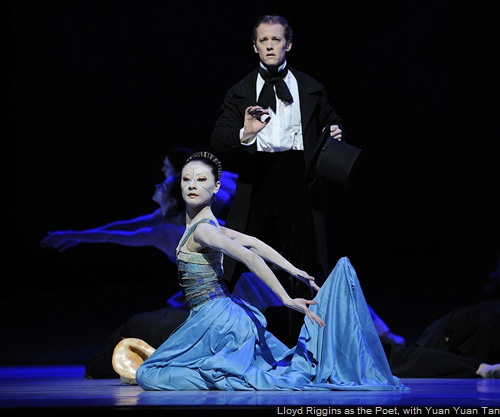
I kept wondering whether Cuban dancer-actress Lorena Feijoo, who was originally cast by Neumeier in this role at SF Ballet, would have added different notes to the character with her natural fire, and balanced the abject masochism that Yuan Yuan Tan brought forth. As Feijoo's partner got injured during rehearsals she was not able to dance the role. We will only know a year from now when, with luck, the Mermaid comes back with Feijoo starring in the role meant for her.
Apart from the overdrawn tedium of the storytelling, another main reason that the ballet is not very engaging or touching lies in its music. Russian Cera Auerbach's mostly atonal composition clobbers the poetic images and subtler shadings with huge orchestra blasts that overplay the drama while offering very little invitation to the dance. Sure, it is tempting to create big story ballets, even with a modern bend. The audience begs for engaging stories and flocks to every Swan Lake, Giselle, Romeo and Juliet. John Neumeier has done it many times before, and done it very successfully, as his brilliant take on Swan Lake, "Illusion ce Schwanensee" from 2001 (available on DVD) proves. But then he had Tchaikovsky as a support. A composer like Tchaikovsky, Prokofiev or Stravinsky might have given this Mermaid emotional backing and some uplifting dance inspiration; perhaps even made her mute misery "sing." But Neumeier's intentions often seem drowned out by the composer's dissonances. I read in a German interview that Neumeier only had the piano score to work with; he had no idea what would come at him out of the orchestra pit.
So, did the choreographer lack of the right music? Was he distracted by the grandiosity of wanting to create a quasi Wagnerian "Gesamtkunstwerk" for ballet? The relentless harping on the Mermaid's humiliation creates a suspicion. One begins to wonder if Neumeier insisted on the mistreatment of the protagonist out of some strange desire to turn the beauty and perfection of a ballerina into its grotesque opposite? Or if he wanted to push the horrors of the story into the audience's face because of a secret identification with Andersen, the outsider, the shamed, self-loathing homosexual artist? Whatever the true motivation, Neumeier's creation of spectacular stage sets for the fairy tale lacks life and love. In this muted ballet the choreographer has not found his voice. Or has he? A sadist's voice?
Photos - Erik Tomasson
|

